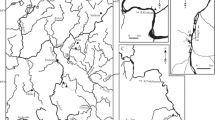Abstract
Compared with Hennig's phylogenetical systematics which has as its aim the retracing of genealogical relations between taxonomic groups, evolutionary morphological systematics is equally justified. Classifications of basic plans, morphological types, and morphofunctional systems of organisms serve as the foundation of evolutionary morphological systems. They are constructed on the basis of thorough understanding and further iteration of morphological transformation in phylogenetical branches based on the constructional pecularities of the morphofunctional systems. The evolutionary morphological approach in systematics is important especially for elaborating macrosystems dealing with vastly divergant groups where it is impossible to trace their real genealogy. The general principles of evolutionary morphological systematics are considered. A variant of the classification system of the Plathelminthes is suggested.
Similar content being viewed by others
References
Ax, P., 1961. Verwandtschaftsbeziehungen und Phylogenie der Turbellarien. Ergebnisse der Biologie 24: 1–68.
Ax, P., 1987. The phylogenetic system (The systematization of organisms on the basis of their phylogenesis). J. Wiley & Sons, Chichester, N.Y., 340 pp.
Ehlers, U., 1991. Comparative morphology of statocysts in the Plathelminthes and Xenoturbellida. Hydrobiologia 227 (Dev. Hydrobiol. 69): 263–271.
Hennig, W., 1966. Phylogenetic systematics. University of Illinois Press, Urbana, Chicago, London, 263 pp.
Karling, T. G., 1940. Zur Morphologie und Systematik der Alloeocoela Cumulata und Rhabdocoela Lecithophora (Turbellaria). Acta Zool. fenn. 26: 1–120.
Mamkaev, Yu. V., 1985. The principle of morphological radiation and its significance for evolutionary morphology. In: J. Mlikovsky, V. J. A. Novak (eds), Evolution and Morphogenesis. Academia, Praha: 421–427.
Mamkaev, Yu. V., 1986. Initial morphological diversity as a criterion in deciphering turbellarian phylogeny. Hydrobiologia 132/Dev. Hydrobiol. 32: 31–33.
Mamkaev, Yu. V., 1987. Resnichnye chervi i metodologicheskie printsipy evolyutsionnoj morfologii. Tr. Zool. Inst. Akad. Nauk USSR 167: 4–33. (Turbellaria and methodological principles of evolutionary morphology. In Russian, English summary).
Mamkaev, Yu. V., 1991. O morfologicheskikh osnovakh sistemy ploskikh chervej. Tr. Zool. Inst. Akad. Nauk USSR 241: 3–25. (On morphological principles of the plathelminthes system. In Russian, English summary).
Markevich, G. I., 1988. Zakonomernosti morfologicheskoj evolutsii slozhnykh skleritno-myshechnykh sistem kolovratok. Problemy Makroevolutsii, S. Severtsov (ed.), Nauka, Moskow: 81–82. (Regularities of the morphological evolution of the complicate sclerit-muscle systems of the Rotatoria. In Russian)
Markevich, G. I., 1990. Istoricheskaya rekonstruktsiya filogeneza kolovratok kak osnova postroeniya ikh makrosistemy. Kolovratki. Materialy Tret'ego Vsesoyuznogo simpoziuma. L. A. Kutikova (ed.), Zool. Inst. Akad. Nauk USSR: 140–156. (Historical reconstruction of the phylogenesis of the Rotatoria as basis for constructing their macrosystem. In Russian.)
Raikova, O. I., 1989. O gomologii kornevykh nitej resnichnogo apparata Acoela i drugikh Turbellaria. DAN SSSR 308, 6: 1506–1509. (On homology of the rootlet apparatus of the Acoela and other Turbellaria. In Russian.)
Reisinger, E., 1960. Was ist Xenoturbella? Zeitschr. wiss. Zool. 164: 188–198.
Remane, A., 1955. Morphologie als Homologienforshung. Zool. Anz. 18. Supplementband: 159–183.
Remane, A., 1956. Die Grundlagen des Naturlichen Systems, der Vergleichenden Anatomie und der Phylogenetik. Akademische Verlagsgesellschaft, Geest & Portik K.-9, Leipzig, 364 S.
Timoshkin, O. A., 1991a. Resnichnye chervi oz. Bajkal. I. Turbellaria Prorhynchidae. Morfologya, sistematika i filogeniya Lecithoepitheliata. Morfologya i evolutsia bespozvonochnykh. A. A. Linevich and E. L. Afanasieva (eds), Nauka, Novosibirsk: 63–185.
Timoshkin, O. A., 1991b. Turbellaria Lecithoepitheliata: morphology, systematics, phylogeny. Hydrobiologia 227 (Dev. Hydrobiol. 69): 323–332.
Author information
Authors and Affiliations
Rights and permissions
About this article
Cite this article
Mamkaev, Y.V. An elaboration of the evolutionary morphological basis for the systematics of the Plathelminthes. Hydrobiologia 305, 15–19 (1995). https://doi.org/10.1007/BF00036357
Issue Date:
DOI: https://doi.org/10.1007/BF00036357



